Challenges Faced by Afghan Refugees in Australia: A Sociological View
VerifiedAdded on 2022/10/16
|10
|2955
|3
Essay
AI Summary
This sociology essay investigates the condition of Afghan refugees in Australia, focusing on their health, communication barriers, and integration challenges. The paper provides an overview of their current status, highlighting the geographical distance between Afghanistan and Australia, the influx of refugees since the US invasion, and the concentration of Afghan communities in urban areas. It addresses issues such as language difficulties, unemployment, discrimination in health services, and the need for mental health initiatives. The essay discusses the impact of cultural differences and the importance of Australian aid, while also pointing out the mental traumas and psychological distress experienced by the refugees. It suggests potential solutions, including improved mental health services, English language programs, and community support groups. The essay emphasizes the need for the Australian government to address these issues, promote integration, and combat discrimination to provide a better future for Afghan refugees, including facilitating trauma counseling, and ensuring access to health and education.
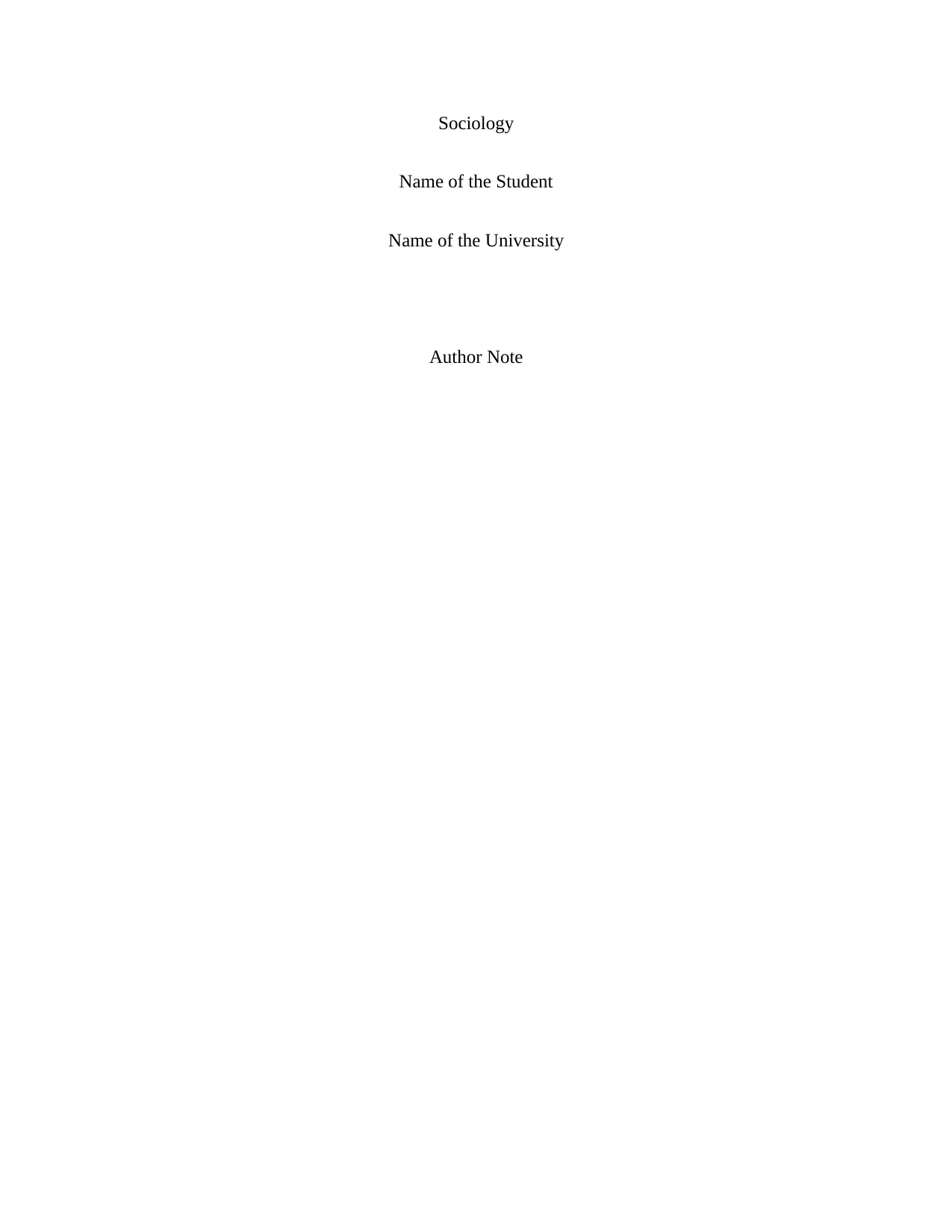
Sociology
Name of the Student
Name of the University
Author Note
Name of the Student
Name of the University
Author Note
Paraphrase This Document
Need a fresh take? Get an instant paraphrase of this document with our AI Paraphraser
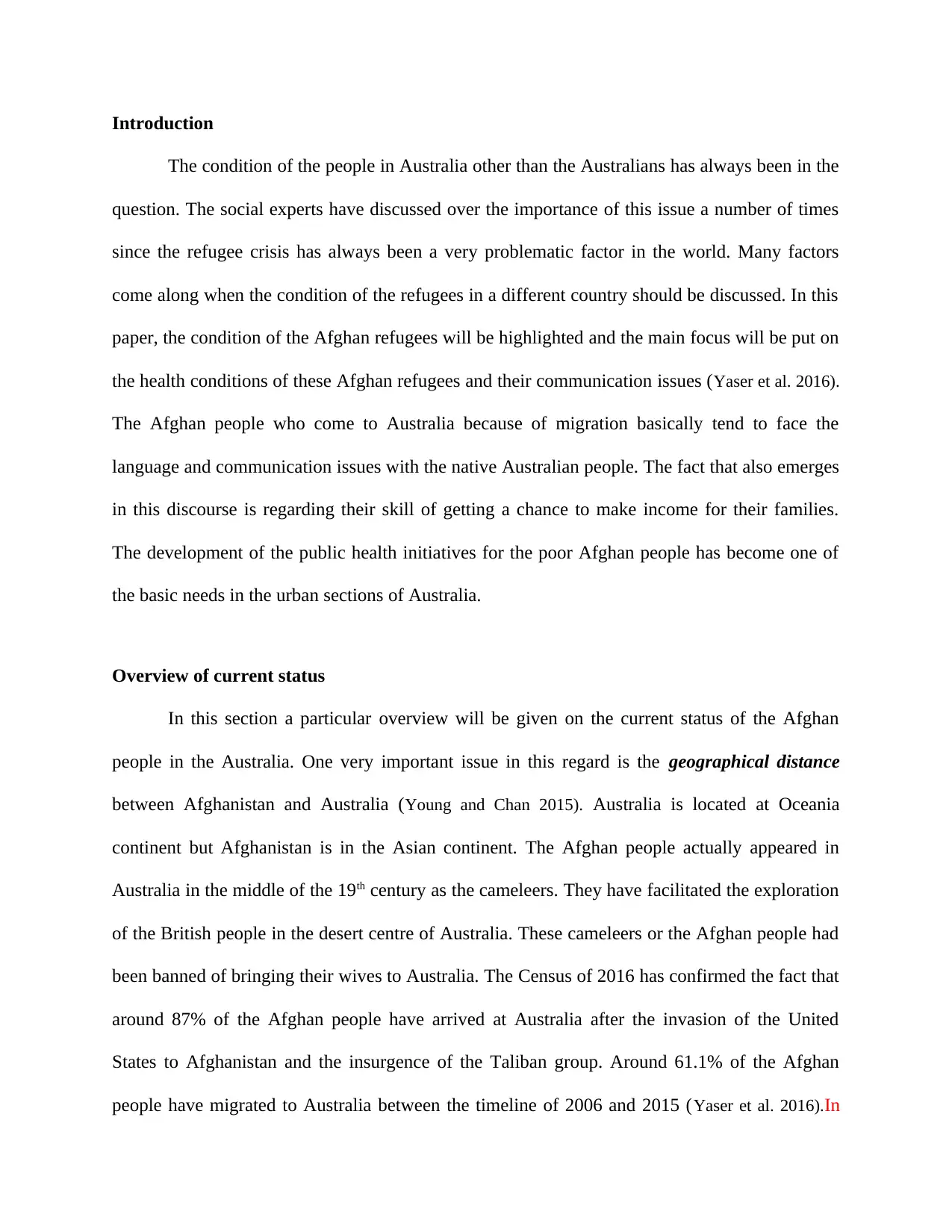
Introduction
The condition of the people in Australia other than the Australians has always been in the
question. The social experts have discussed over the importance of this issue a number of times
since the refugee crisis has always been a very problematic factor in the world. Many factors
come along when the condition of the refugees in a different country should be discussed. In this
paper, the condition of the Afghan refugees will be highlighted and the main focus will be put on
the health conditions of these Afghan refugees and their communication issues (Yaser et al. 2016).
The Afghan people who come to Australia because of migration basically tend to face the
language and communication issues with the native Australian people. The fact that also emerges
in this discourse is regarding their skill of getting a chance to make income for their families.
The development of the public health initiatives for the poor Afghan people has become one of
the basic needs in the urban sections of Australia.
Overview of current status
In this section a particular overview will be given on the current status of the Afghan
people in the Australia. One very important issue in this regard is the geographical distance
between Afghanistan and Australia (Young and Chan 2015). Australia is located at Oceania
continent but Afghanistan is in the Asian continent. The Afghan people actually appeared in
Australia in the middle of the 19th century as the cameleers. They have facilitated the exploration
of the British people in the desert centre of Australia. These cameleers or the Afghan people had
been banned of bringing their wives to Australia. The Census of 2016 has confirmed the fact that
around 87% of the Afghan people have arrived at Australia after the invasion of the United
States to Afghanistan and the insurgence of the Taliban group. Around 61.1% of the Afghan
people have migrated to Australia between the timeline of 2006 and 2015 (Yaser et al. 2016).In
The condition of the people in Australia other than the Australians has always been in the
question. The social experts have discussed over the importance of this issue a number of times
since the refugee crisis has always been a very problematic factor in the world. Many factors
come along when the condition of the refugees in a different country should be discussed. In this
paper, the condition of the Afghan refugees will be highlighted and the main focus will be put on
the health conditions of these Afghan refugees and their communication issues (Yaser et al. 2016).
The Afghan people who come to Australia because of migration basically tend to face the
language and communication issues with the native Australian people. The fact that also emerges
in this discourse is regarding their skill of getting a chance to make income for their families.
The development of the public health initiatives for the poor Afghan people has become one of
the basic needs in the urban sections of Australia.
Overview of current status
In this section a particular overview will be given on the current status of the Afghan
people in the Australia. One very important issue in this regard is the geographical distance
between Afghanistan and Australia (Young and Chan 2015). Australia is located at Oceania
continent but Afghanistan is in the Asian continent. The Afghan people actually appeared in
Australia in the middle of the 19th century as the cameleers. They have facilitated the exploration
of the British people in the desert centre of Australia. These cameleers or the Afghan people had
been banned of bringing their wives to Australia. The Census of 2016 has confirmed the fact that
around 87% of the Afghan people have arrived at Australia after the invasion of the United
States to Afghanistan and the insurgence of the Taliban group. Around 61.1% of the Afghan
people have migrated to Australia between the timeline of 2006 and 2015 (Yaser et al. 2016).In
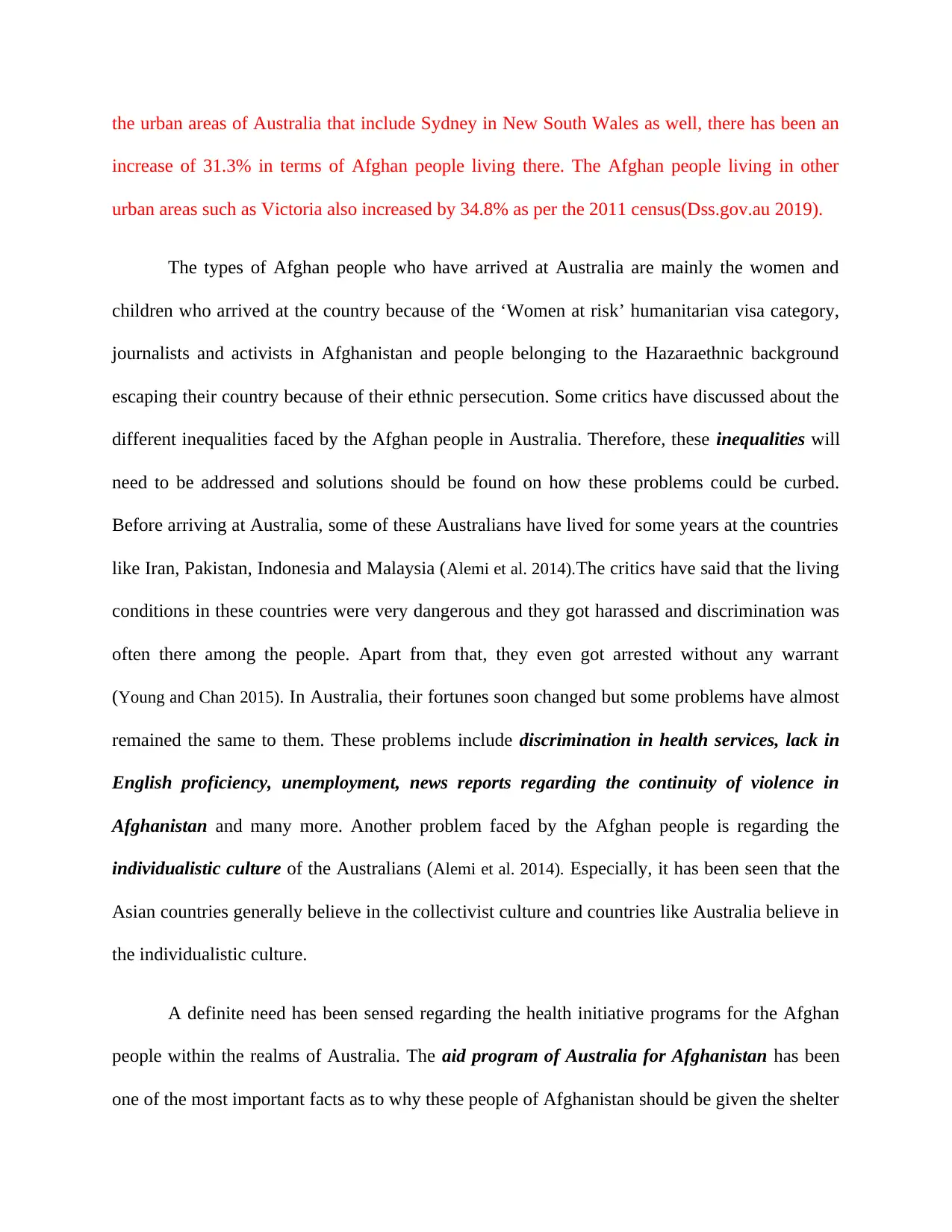
the urban areas of Australia that include Sydney in New South Wales as well, there has been an
increase of 31.3% in terms of Afghan people living there. The Afghan people living in other
urban areas such as Victoria also increased by 34.8% as per the 2011 census(Dss.gov.au 2019).
The types of Afghan people who have arrived at Australia are mainly the women and
children who arrived at the country because of the ‘Women at risk’ humanitarian visa category,
journalists and activists in Afghanistan and people belonging to the Hazaraethnic background
escaping their country because of their ethnic persecution. Some critics have discussed about the
different inequalities faced by the Afghan people in Australia. Therefore, these inequalities will
need to be addressed and solutions should be found on how these problems could be curbed.
Before arriving at Australia, some of these Australians have lived for some years at the countries
like Iran, Pakistan, Indonesia and Malaysia (Alemi et al. 2014).The critics have said that the living
conditions in these countries were very dangerous and they got harassed and discrimination was
often there among the people. Apart from that, they even got arrested without any warrant
(Young and Chan 2015). In Australia, their fortunes soon changed but some problems have almost
remained the same to them. These problems include discrimination in health services, lack in
English proficiency, unemployment, news reports regarding the continuity of violence in
Afghanistan and many more. Another problem faced by the Afghan people is regarding the
individualistic culture of the Australians (Alemi et al. 2014). Especially, it has been seen that the
Asian countries generally believe in the collectivist culture and countries like Australia believe in
the individualistic culture.
A definite need has been sensed regarding the health initiative programs for the Afghan
people within the realms of Australia. The aid program of Australia for Afghanistan has been
one of the most important facts as to why these people of Afghanistan should be given the shelter
increase of 31.3% in terms of Afghan people living there. The Afghan people living in other
urban areas such as Victoria also increased by 34.8% as per the 2011 census(Dss.gov.au 2019).
The types of Afghan people who have arrived at Australia are mainly the women and
children who arrived at the country because of the ‘Women at risk’ humanitarian visa category,
journalists and activists in Afghanistan and people belonging to the Hazaraethnic background
escaping their country because of their ethnic persecution. Some critics have discussed about the
different inequalities faced by the Afghan people in Australia. Therefore, these inequalities will
need to be addressed and solutions should be found on how these problems could be curbed.
Before arriving at Australia, some of these Australians have lived for some years at the countries
like Iran, Pakistan, Indonesia and Malaysia (Alemi et al. 2014).The critics have said that the living
conditions in these countries were very dangerous and they got harassed and discrimination was
often there among the people. Apart from that, they even got arrested without any warrant
(Young and Chan 2015). In Australia, their fortunes soon changed but some problems have almost
remained the same to them. These problems include discrimination in health services, lack in
English proficiency, unemployment, news reports regarding the continuity of violence in
Afghanistan and many more. Another problem faced by the Afghan people is regarding the
individualistic culture of the Australians (Alemi et al. 2014). Especially, it has been seen that the
Asian countries generally believe in the collectivist culture and countries like Australia believe in
the individualistic culture.
A definite need has been sensed regarding the health initiative programs for the Afghan
people within the realms of Australia. The aid program of Australia for Afghanistan has been
one of the most important facts as to why these people of Afghanistan should be given the shelter
⊘ This is a preview!⊘
Do you want full access?
Subscribe today to unlock all pages.

Trusted by 1+ million students worldwide
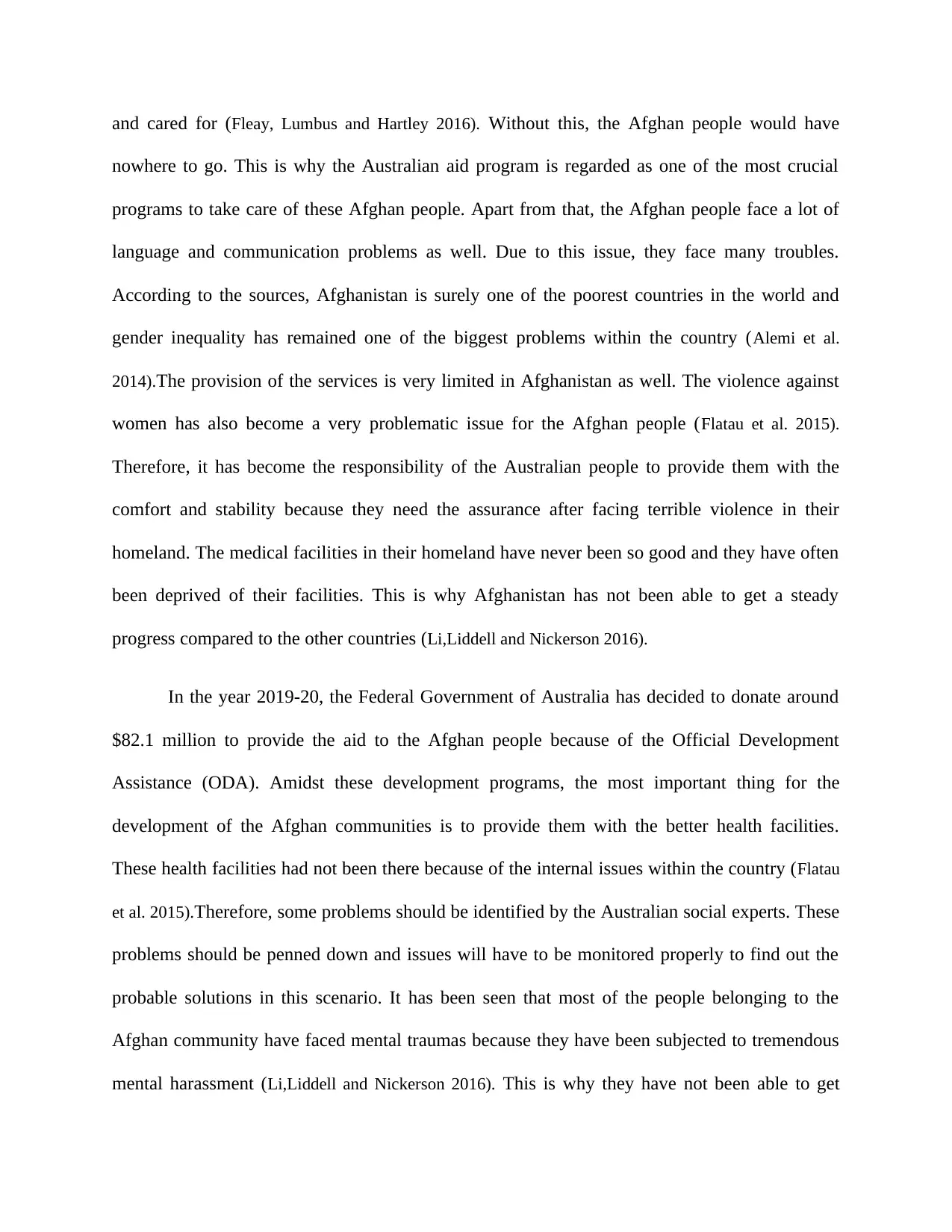
and cared for (Fleay, Lumbus and Hartley 2016). Without this, the Afghan people would have
nowhere to go. This is why the Australian aid program is regarded as one of the most crucial
programs to take care of these Afghan people. Apart from that, the Afghan people face a lot of
language and communication problems as well. Due to this issue, they face many troubles.
According to the sources, Afghanistan is surely one of the poorest countries in the world and
gender inequality has remained one of the biggest problems within the country (Alemi et al.
2014).The provision of the services is very limited in Afghanistan as well. The violence against
women has also become a very problematic issue for the Afghan people (Flatau et al. 2015).
Therefore, it has become the responsibility of the Australian people to provide them with the
comfort and stability because they need the assurance after facing terrible violence in their
homeland. The medical facilities in their homeland have never been so good and they have often
been deprived of their facilities. This is why Afghanistan has not been able to get a steady
progress compared to the other countries (Li,Liddell and Nickerson 2016).
In the year 2019-20, the Federal Government of Australia has decided to donate around
$82.1 million to provide the aid to the Afghan people because of the Official Development
Assistance (ODA). Amidst these development programs, the most important thing for the
development of the Afghan communities is to provide them with the better health facilities.
These health facilities had not been there because of the internal issues within the country (Flatau
et al. 2015).Therefore, some problems should be identified by the Australian social experts. These
problems should be penned down and issues will have to be monitored properly to find out the
probable solutions in this scenario. It has been seen that most of the people belonging to the
Afghan community have faced mental traumas because they have been subjected to tremendous
mental harassment (Li,Liddell and Nickerson 2016). This is why they have not been able to get
nowhere to go. This is why the Australian aid program is regarded as one of the most crucial
programs to take care of these Afghan people. Apart from that, the Afghan people face a lot of
language and communication problems as well. Due to this issue, they face many troubles.
According to the sources, Afghanistan is surely one of the poorest countries in the world and
gender inequality has remained one of the biggest problems within the country (Alemi et al.
2014).The provision of the services is very limited in Afghanistan as well. The violence against
women has also become a very problematic issue for the Afghan people (Flatau et al. 2015).
Therefore, it has become the responsibility of the Australian people to provide them with the
comfort and stability because they need the assurance after facing terrible violence in their
homeland. The medical facilities in their homeland have never been so good and they have often
been deprived of their facilities. This is why Afghanistan has not been able to get a steady
progress compared to the other countries (Li,Liddell and Nickerson 2016).
In the year 2019-20, the Federal Government of Australia has decided to donate around
$82.1 million to provide the aid to the Afghan people because of the Official Development
Assistance (ODA). Amidst these development programs, the most important thing for the
development of the Afghan communities is to provide them with the better health facilities.
These health facilities had not been there because of the internal issues within the country (Flatau
et al. 2015).Therefore, some problems should be identified by the Australian social experts. These
problems should be penned down and issues will have to be monitored properly to find out the
probable solutions in this scenario. It has been seen that most of the people belonging to the
Afghan community have faced mental traumas because they have been subjected to tremendous
mental harassment (Li,Liddell and Nickerson 2016). This is why they have not been able to get
Paraphrase This Document
Need a fresh take? Get an instant paraphrase of this document with our AI Paraphraser
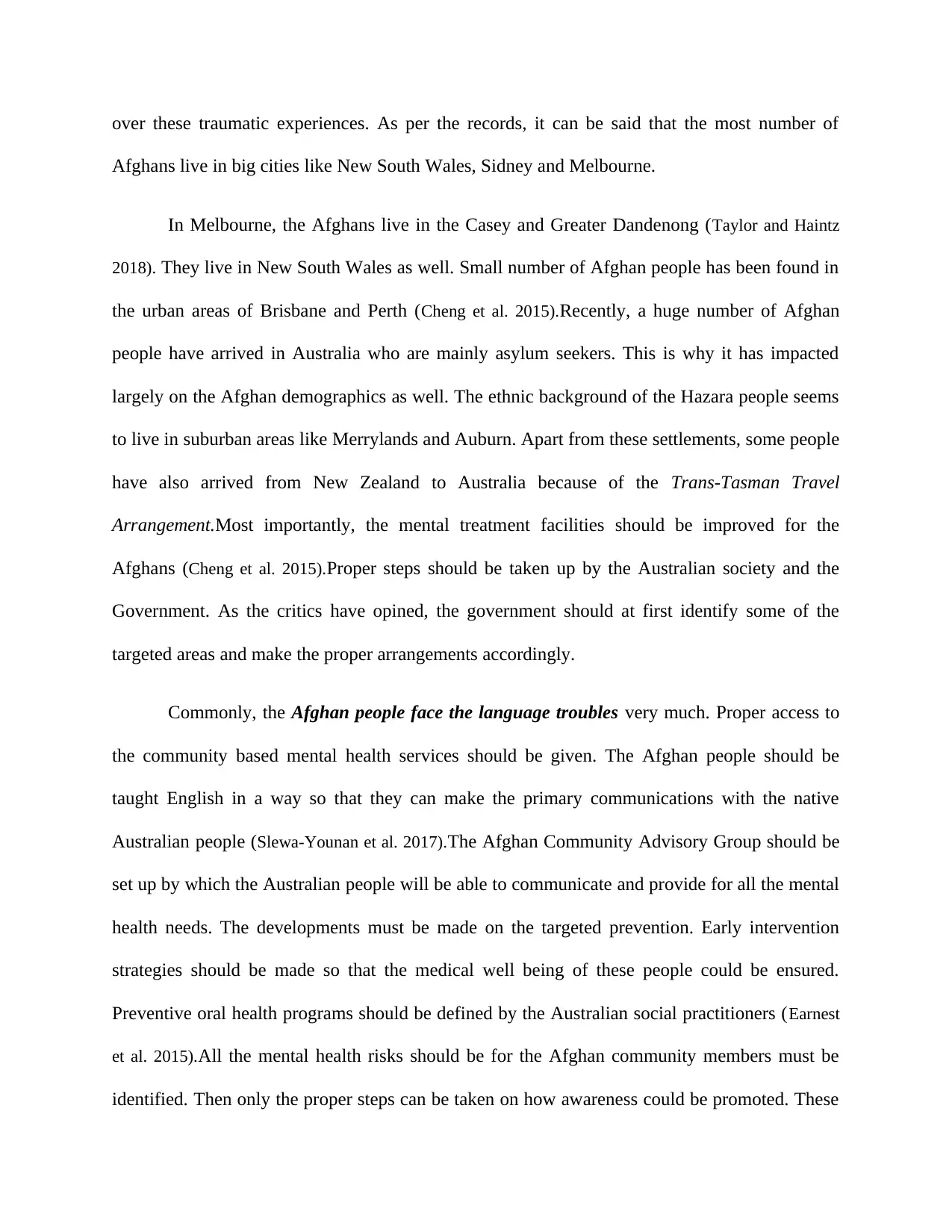
over these traumatic experiences. As per the records, it can be said that the most number of
Afghans live in big cities like New South Wales, Sidney and Melbourne.
In Melbourne, the Afghans live in the Casey and Greater Dandenong (Taylor and Haintz
2018). They live in New South Wales as well. Small number of Afghan people has been found in
the urban areas of Brisbane and Perth (Cheng et al. 2015).Recently, a huge number of Afghan
people have arrived in Australia who are mainly asylum seekers. This is why it has impacted
largely on the Afghan demographics as well. The ethnic background of the Hazara people seems
to live in suburban areas like Merrylands and Auburn. Apart from these settlements, some people
have also arrived from New Zealand to Australia because of the Trans-Tasman Travel
Arrangement.Most importantly, the mental treatment facilities should be improved for the
Afghans (Cheng et al. 2015).Proper steps should be taken up by the Australian society and the
Government. As the critics have opined, the government should at first identify some of the
targeted areas and make the proper arrangements accordingly.
Commonly, the Afghan people face the language troubles very much. Proper access to
the community based mental health services should be given. The Afghan people should be
taught English in a way so that they can make the primary communications with the native
Australian people (Slewa-Younan et al. 2017).The Afghan Community Advisory Group should be
set up by which the Australian people will be able to communicate and provide for all the mental
health needs. The developments must be made on the targeted prevention. Early intervention
strategies should be made so that the medical well being of these people could be ensured.
Preventive oral health programs should be defined by the Australian social practitioners (Earnest
et al. 2015).All the mental health risks should be for the Afghan community members must be
identified. Then only the proper steps can be taken on how awareness could be promoted. These
Afghans live in big cities like New South Wales, Sidney and Melbourne.
In Melbourne, the Afghans live in the Casey and Greater Dandenong (Taylor and Haintz
2018). They live in New South Wales as well. Small number of Afghan people has been found in
the urban areas of Brisbane and Perth (Cheng et al. 2015).Recently, a huge number of Afghan
people have arrived in Australia who are mainly asylum seekers. This is why it has impacted
largely on the Afghan demographics as well. The ethnic background of the Hazara people seems
to live in suburban areas like Merrylands and Auburn. Apart from these settlements, some people
have also arrived from New Zealand to Australia because of the Trans-Tasman Travel
Arrangement.Most importantly, the mental treatment facilities should be improved for the
Afghans (Cheng et al. 2015).Proper steps should be taken up by the Australian society and the
Government. As the critics have opined, the government should at first identify some of the
targeted areas and make the proper arrangements accordingly.
Commonly, the Afghan people face the language troubles very much. Proper access to
the community based mental health services should be given. The Afghan people should be
taught English in a way so that they can make the primary communications with the native
Australian people (Slewa-Younan et al. 2017).The Afghan Community Advisory Group should be
set up by which the Australian people will be able to communicate and provide for all the mental
health needs. The developments must be made on the targeted prevention. Early intervention
strategies should be made so that the medical well being of these people could be ensured.
Preventive oral health programs should be defined by the Australian social practitioners (Earnest
et al. 2015).All the mental health risks should be for the Afghan community members must be
identified. Then only the proper steps can be taken on how awareness could be promoted. These
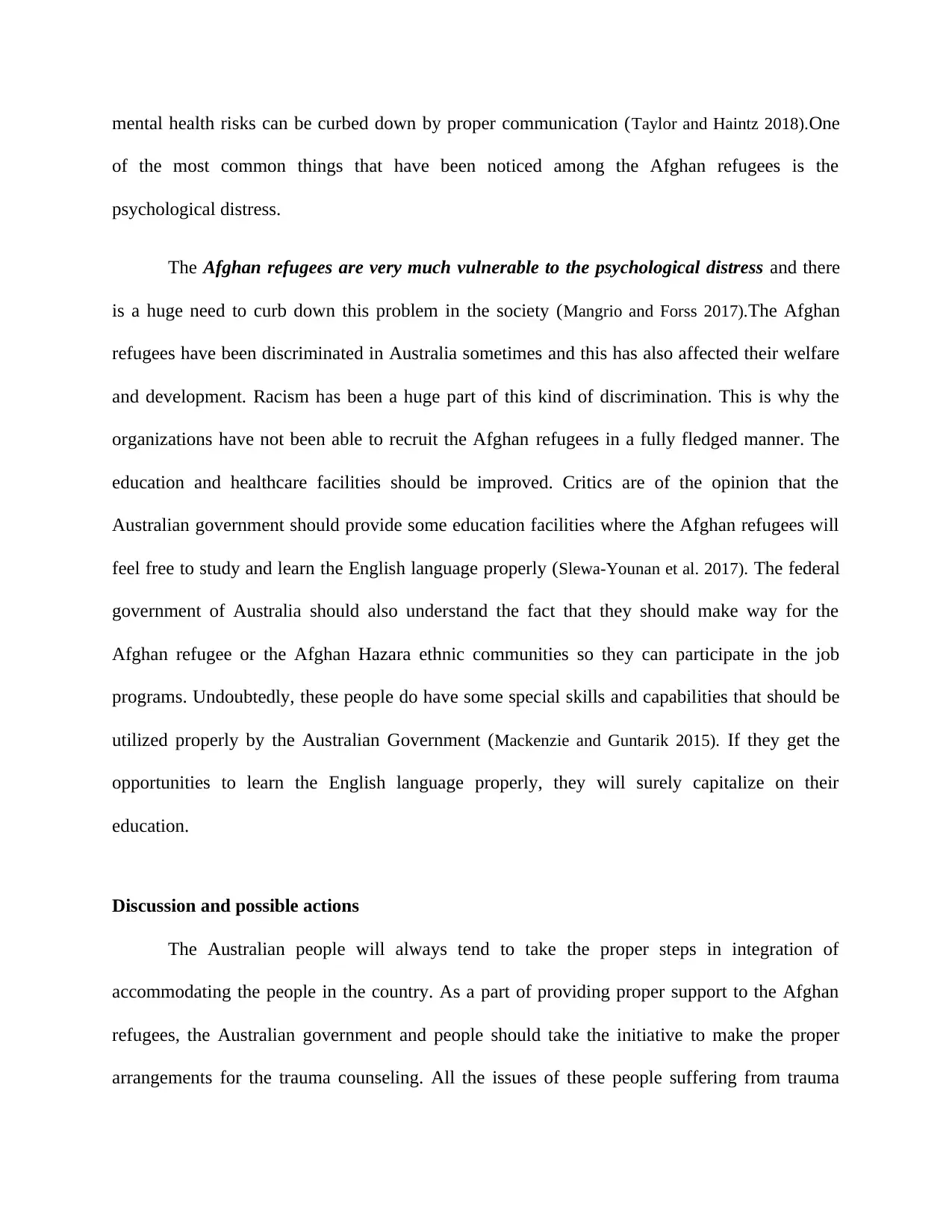
mental health risks can be curbed down by proper communication (Taylor and Haintz 2018).One
of the most common things that have been noticed among the Afghan refugees is the
psychological distress.
The Afghan refugees are very much vulnerable to the psychological distress and there
is a huge need to curb down this problem in the society (Mangrio and Forss 2017).The Afghan
refugees have been discriminated in Australia sometimes and this has also affected their welfare
and development. Racism has been a huge part of this kind of discrimination. This is why the
organizations have not been able to recruit the Afghan refugees in a fully fledged manner. The
education and healthcare facilities should be improved. Critics are of the opinion that the
Australian government should provide some education facilities where the Afghan refugees will
feel free to study and learn the English language properly (Slewa-Younan et al. 2017). The federal
government of Australia should also understand the fact that they should make way for the
Afghan refugee or the Afghan Hazara ethnic communities so they can participate in the job
programs. Undoubtedly, these people do have some special skills and capabilities that should be
utilized properly by the Australian Government (Mackenzie and Guntarik 2015). If they get the
opportunities to learn the English language properly, they will surely capitalize on their
education.
Discussion and possible actions
The Australian people will always tend to take the proper steps in integration of
accommodating the people in the country. As a part of providing proper support to the Afghan
refugees, the Australian government and people should take the initiative to make the proper
arrangements for the trauma counseling. All the issues of these people suffering from trauma
of the most common things that have been noticed among the Afghan refugees is the
psychological distress.
The Afghan refugees are very much vulnerable to the psychological distress and there
is a huge need to curb down this problem in the society (Mangrio and Forss 2017).The Afghan
refugees have been discriminated in Australia sometimes and this has also affected their welfare
and development. Racism has been a huge part of this kind of discrimination. This is why the
organizations have not been able to recruit the Afghan refugees in a fully fledged manner. The
education and healthcare facilities should be improved. Critics are of the opinion that the
Australian government should provide some education facilities where the Afghan refugees will
feel free to study and learn the English language properly (Slewa-Younan et al. 2017). The federal
government of Australia should also understand the fact that they should make way for the
Afghan refugee or the Afghan Hazara ethnic communities so they can participate in the job
programs. Undoubtedly, these people do have some special skills and capabilities that should be
utilized properly by the Australian Government (Mackenzie and Guntarik 2015). If they get the
opportunities to learn the English language properly, they will surely capitalize on their
education.
Discussion and possible actions
The Australian people will always tend to take the proper steps in integration of
accommodating the people in the country. As a part of providing proper support to the Afghan
refugees, the Australian government and people should take the initiative to make the proper
arrangements for the trauma counseling. All the issues of these people suffering from trauma
⊘ This is a preview!⊘
Do you want full access?
Subscribe today to unlock all pages.

Trusted by 1+ million students worldwide
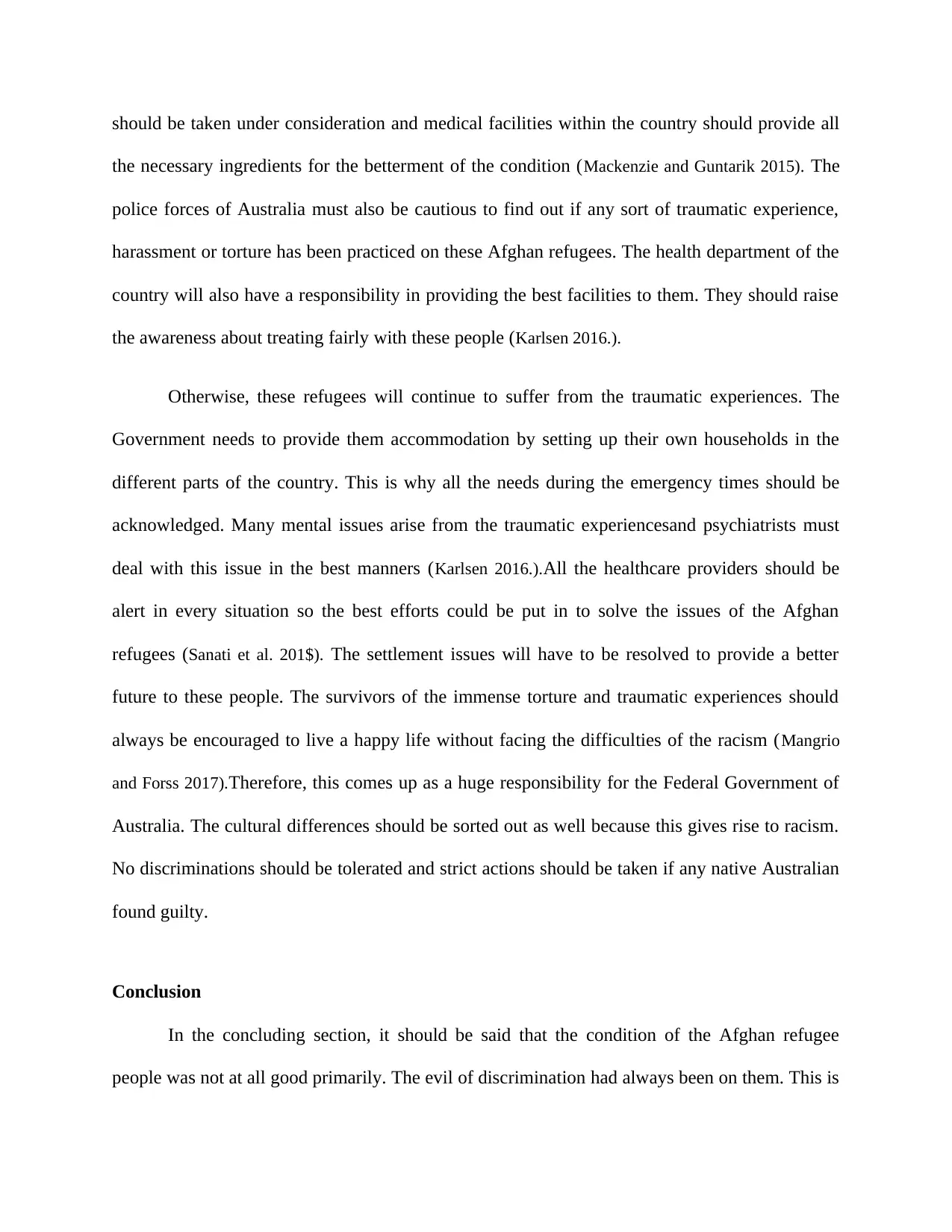
should be taken under consideration and medical facilities within the country should provide all
the necessary ingredients for the betterment of the condition (Mackenzie and Guntarik 2015). The
police forces of Australia must also be cautious to find out if any sort of traumatic experience,
harassment or torture has been practiced on these Afghan refugees. The health department of the
country will also have a responsibility in providing the best facilities to them. They should raise
the awareness about treating fairly with these people (Karlsen 2016.).
Otherwise, these refugees will continue to suffer from the traumatic experiences. The
Government needs to provide them accommodation by setting up their own households in the
different parts of the country. This is why all the needs during the emergency times should be
acknowledged. Many mental issues arise from the traumatic experiencesand psychiatrists must
deal with this issue in the best manners (Karlsen 2016.).All the healthcare providers should be
alert in every situation so the best efforts could be put in to solve the issues of the Afghan
refugees (Sanati et al. 201$). The settlement issues will have to be resolved to provide a better
future to these people. The survivors of the immense torture and traumatic experiences should
always be encouraged to live a happy life without facing the difficulties of the racism (Mangrio
and Forss 2017).Therefore, this comes up as a huge responsibility for the Federal Government of
Australia. The cultural differences should be sorted out as well because this gives rise to racism.
No discriminations should be tolerated and strict actions should be taken if any native Australian
found guilty.
Conclusion
In the concluding section, it should be said that the condition of the Afghan refugee
people was not at all good primarily. The evil of discrimination had always been on them. This is
the necessary ingredients for the betterment of the condition (Mackenzie and Guntarik 2015). The
police forces of Australia must also be cautious to find out if any sort of traumatic experience,
harassment or torture has been practiced on these Afghan refugees. The health department of the
country will also have a responsibility in providing the best facilities to them. They should raise
the awareness about treating fairly with these people (Karlsen 2016.).
Otherwise, these refugees will continue to suffer from the traumatic experiences. The
Government needs to provide them accommodation by setting up their own households in the
different parts of the country. This is why all the needs during the emergency times should be
acknowledged. Many mental issues arise from the traumatic experiencesand psychiatrists must
deal with this issue in the best manners (Karlsen 2016.).All the healthcare providers should be
alert in every situation so the best efforts could be put in to solve the issues of the Afghan
refugees (Sanati et al. 201$). The settlement issues will have to be resolved to provide a better
future to these people. The survivors of the immense torture and traumatic experiences should
always be encouraged to live a happy life without facing the difficulties of the racism (Mangrio
and Forss 2017).Therefore, this comes up as a huge responsibility for the Federal Government of
Australia. The cultural differences should be sorted out as well because this gives rise to racism.
No discriminations should be tolerated and strict actions should be taken if any native Australian
found guilty.
Conclusion
In the concluding section, it should be said that the condition of the Afghan refugee
people was not at all good primarily. The evil of discrimination had always been on them. This is
Paraphrase This Document
Need a fresh take? Get an instant paraphrase of this document with our AI Paraphraser
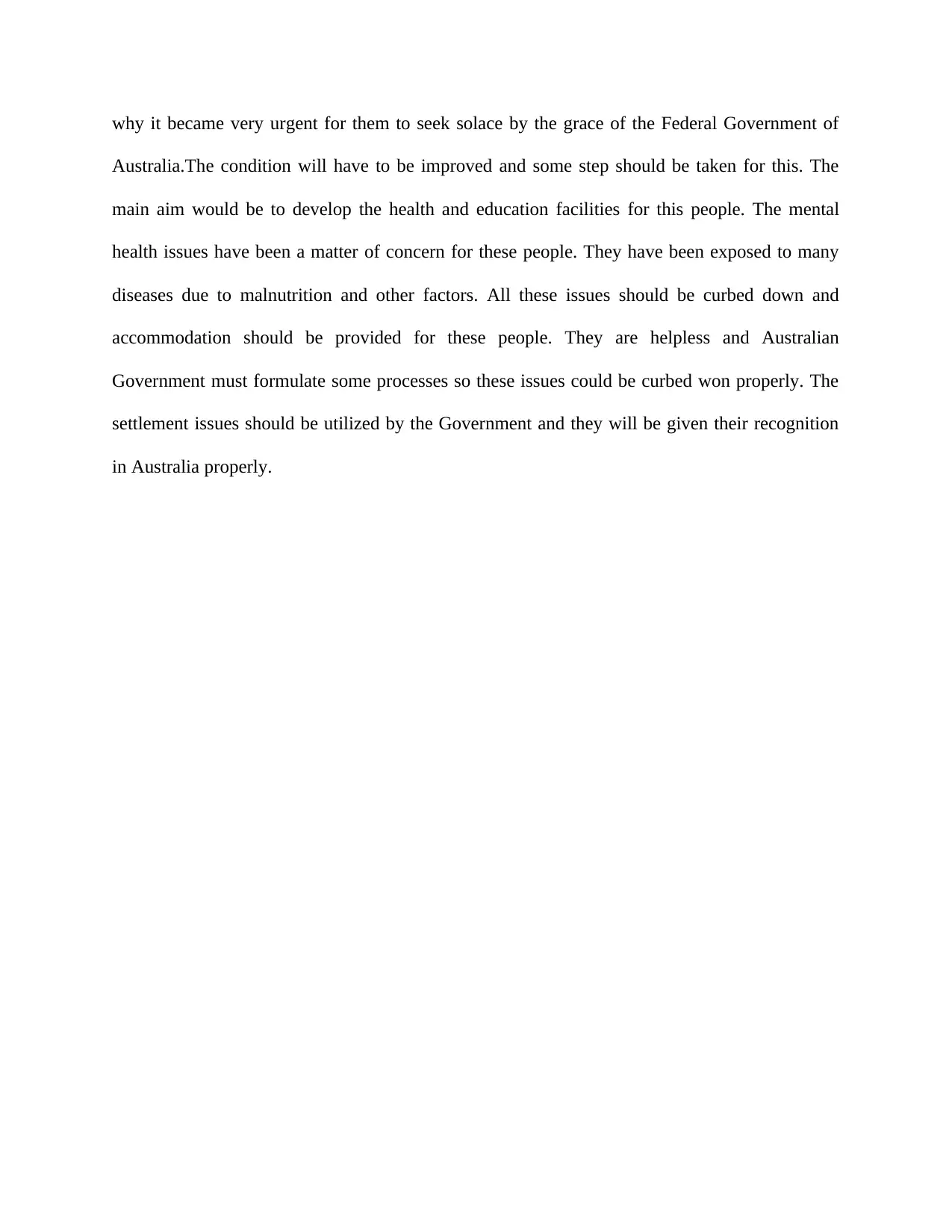
why it became very urgent for them to seek solace by the grace of the Federal Government of
Australia.The condition will have to be improved and some step should be taken for this. The
main aim would be to develop the health and education facilities for this people. The mental
health issues have been a matter of concern for these people. They have been exposed to many
diseases due to malnutrition and other factors. All these issues should be curbed down and
accommodation should be provided for these people. They are helpless and Australian
Government must formulate some processes so these issues could be curbed won properly. The
settlement issues should be utilized by the Government and they will be given their recognition
in Australia properly.
Australia.The condition will have to be improved and some step should be taken for this. The
main aim would be to develop the health and education facilities for this people. The mental
health issues have been a matter of concern for these people. They have been exposed to many
diseases due to malnutrition and other factors. All these issues should be curbed down and
accommodation should be provided for these people. They are helpless and Australian
Government must formulate some processes so these issues could be curbed won properly. The
settlement issues should be utilized by the Government and they will be given their recognition
in Australia properly.
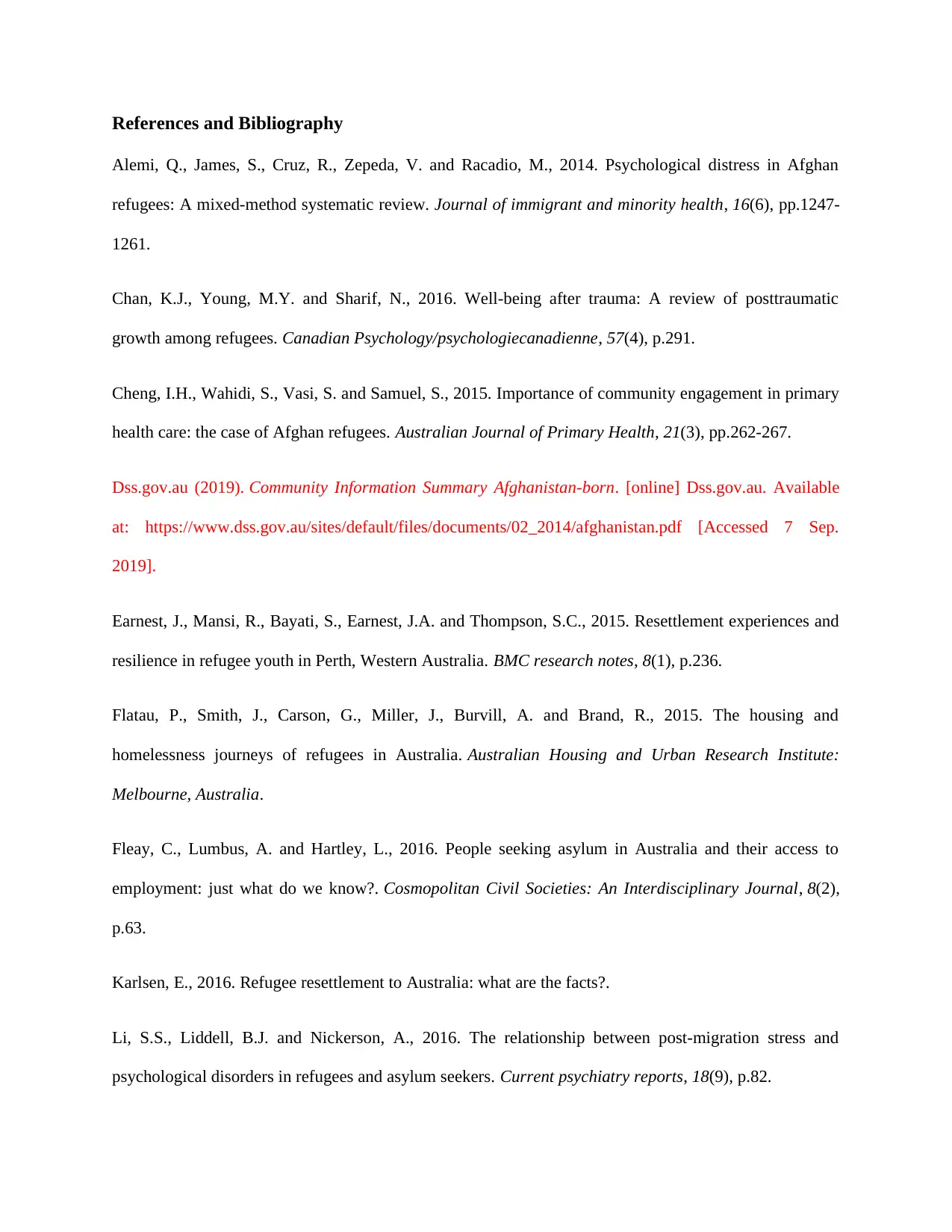
References and Bibliography
Alemi, Q., James, S., Cruz, R., Zepeda, V. and Racadio, M., 2014. Psychological distress in Afghan
refugees: A mixed-method systematic review. Journal of immigrant and minority health, 16(6), pp.1247-
1261.
Chan, K.J., Young, M.Y. and Sharif, N., 2016. Well-being after trauma: A review of posttraumatic
growth among refugees. Canadian Psychology/psychologiecanadienne, 57(4), p.291.
Cheng, I.H., Wahidi, S., Vasi, S. and Samuel, S., 2015. Importance of community engagement in primary
health care: the case of Afghan refugees. Australian Journal of Primary Health, 21(3), pp.262-267.
Dss.gov.au (2019). Community Information Summary Afghanistan-born. [online] Dss.gov.au. Available
at: https://www.dss.gov.au/sites/default/files/documents/02_2014/afghanistan.pdf [Accessed 7 Sep.
2019].
Earnest, J., Mansi, R., Bayati, S., Earnest, J.A. and Thompson, S.C., 2015. Resettlement experiences and
resilience in refugee youth in Perth, Western Australia. BMC research notes, 8(1), p.236.
Flatau, P., Smith, J., Carson, G., Miller, J., Burvill, A. and Brand, R., 2015. The housing and
homelessness journeys of refugees in Australia. Australian Housing and Urban Research Institute:
Melbourne, Australia.
Fleay, C., Lumbus, A. and Hartley, L., 2016. People seeking asylum in Australia and their access to
employment: just what do we know?. Cosmopolitan Civil Societies: An Interdisciplinary Journal, 8(2),
p.63.
Karlsen, E., 2016. Refugee resettlement to Australia: what are the facts?.
Li, S.S., Liddell, B.J. and Nickerson, A., 2016. The relationship between post-migration stress and
psychological disorders in refugees and asylum seekers. Current psychiatry reports, 18(9), p.82.
Alemi, Q., James, S., Cruz, R., Zepeda, V. and Racadio, M., 2014. Psychological distress in Afghan
refugees: A mixed-method systematic review. Journal of immigrant and minority health, 16(6), pp.1247-
1261.
Chan, K.J., Young, M.Y. and Sharif, N., 2016. Well-being after trauma: A review of posttraumatic
growth among refugees. Canadian Psychology/psychologiecanadienne, 57(4), p.291.
Cheng, I.H., Wahidi, S., Vasi, S. and Samuel, S., 2015. Importance of community engagement in primary
health care: the case of Afghan refugees. Australian Journal of Primary Health, 21(3), pp.262-267.
Dss.gov.au (2019). Community Information Summary Afghanistan-born. [online] Dss.gov.au. Available
at: https://www.dss.gov.au/sites/default/files/documents/02_2014/afghanistan.pdf [Accessed 7 Sep.
2019].
Earnest, J., Mansi, R., Bayati, S., Earnest, J.A. and Thompson, S.C., 2015. Resettlement experiences and
resilience in refugee youth in Perth, Western Australia. BMC research notes, 8(1), p.236.
Flatau, P., Smith, J., Carson, G., Miller, J., Burvill, A. and Brand, R., 2015. The housing and
homelessness journeys of refugees in Australia. Australian Housing and Urban Research Institute:
Melbourne, Australia.
Fleay, C., Lumbus, A. and Hartley, L., 2016. People seeking asylum in Australia and their access to
employment: just what do we know?. Cosmopolitan Civil Societies: An Interdisciplinary Journal, 8(2),
p.63.
Karlsen, E., 2016. Refugee resettlement to Australia: what are the facts?.
Li, S.S., Liddell, B.J. and Nickerson, A., 2016. The relationship between post-migration stress and
psychological disorders in refugees and asylum seekers. Current psychiatry reports, 18(9), p.82.
⊘ This is a preview!⊘
Do you want full access?
Subscribe today to unlock all pages.

Trusted by 1+ million students worldwide
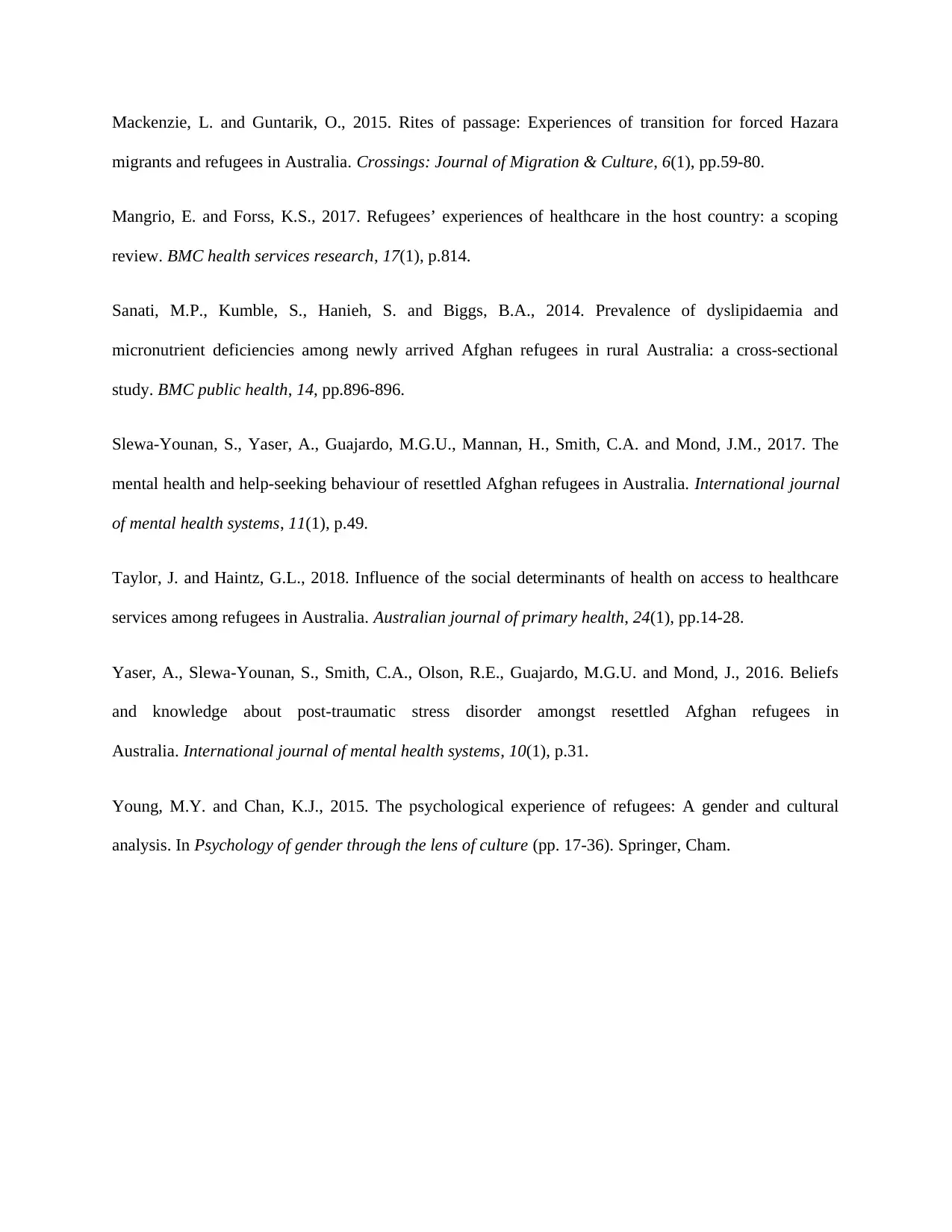
Mackenzie, L. and Guntarik, O., 2015. Rites of passage: Experiences of transition for forced Hazara
migrants and refugees in Australia. Crossings: Journal of Migration & Culture, 6(1), pp.59-80.
Mangrio, E. and Forss, K.S., 2017. Refugees’ experiences of healthcare in the host country: a scoping
review. BMC health services research, 17(1), p.814.
Sanati, M.P., Kumble, S., Hanieh, S. and Biggs, B.A., 2014. Prevalence of dyslipidaemia and
micronutrient deficiencies among newly arrived Afghan refugees in rural Australia: a cross-sectional
study. BMC public health, 14, pp.896-896.
Slewa-Younan, S., Yaser, A., Guajardo, M.G.U., Mannan, H., Smith, C.A. and Mond, J.M., 2017. The
mental health and help-seeking behaviour of resettled Afghan refugees in Australia. International journal
of mental health systems, 11(1), p.49.
Taylor, J. and Haintz, G.L., 2018. Influence of the social determinants of health on access to healthcare
services among refugees in Australia. Australian journal of primary health, 24(1), pp.14-28.
Yaser, A., Slewa-Younan, S., Smith, C.A., Olson, R.E., Guajardo, M.G.U. and Mond, J., 2016. Beliefs
and knowledge about post-traumatic stress disorder amongst resettled Afghan refugees in
Australia. International journal of mental health systems, 10(1), p.31.
Young, M.Y. and Chan, K.J., 2015. The psychological experience of refugees: A gender and cultural
analysis. In Psychology of gender through the lens of culture (pp. 17-36). Springer, Cham.
migrants and refugees in Australia. Crossings: Journal of Migration & Culture, 6(1), pp.59-80.
Mangrio, E. and Forss, K.S., 2017. Refugees’ experiences of healthcare in the host country: a scoping
review. BMC health services research, 17(1), p.814.
Sanati, M.P., Kumble, S., Hanieh, S. and Biggs, B.A., 2014. Prevalence of dyslipidaemia and
micronutrient deficiencies among newly arrived Afghan refugees in rural Australia: a cross-sectional
study. BMC public health, 14, pp.896-896.
Slewa-Younan, S., Yaser, A., Guajardo, M.G.U., Mannan, H., Smith, C.A. and Mond, J.M., 2017. The
mental health and help-seeking behaviour of resettled Afghan refugees in Australia. International journal
of mental health systems, 11(1), p.49.
Taylor, J. and Haintz, G.L., 2018. Influence of the social determinants of health on access to healthcare
services among refugees in Australia. Australian journal of primary health, 24(1), pp.14-28.
Yaser, A., Slewa-Younan, S., Smith, C.A., Olson, R.E., Guajardo, M.G.U. and Mond, J., 2016. Beliefs
and knowledge about post-traumatic stress disorder amongst resettled Afghan refugees in
Australia. International journal of mental health systems, 10(1), p.31.
Young, M.Y. and Chan, K.J., 2015. The psychological experience of refugees: A gender and cultural
analysis. In Psychology of gender through the lens of culture (pp. 17-36). Springer, Cham.
1 out of 10
Related Documents
Your All-in-One AI-Powered Toolkit for Academic Success.
+13062052269
info@desklib.com
Available 24*7 on WhatsApp / Email
![[object Object]](/_next/static/media/star-bottom.7253800d.svg)
Unlock your academic potential
Copyright © 2020–2025 A2Z Services. All Rights Reserved. Developed and managed by ZUCOL.





